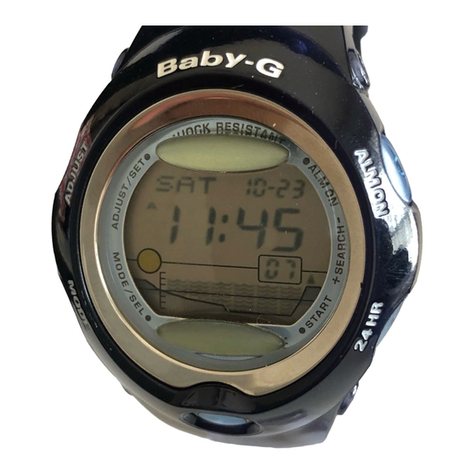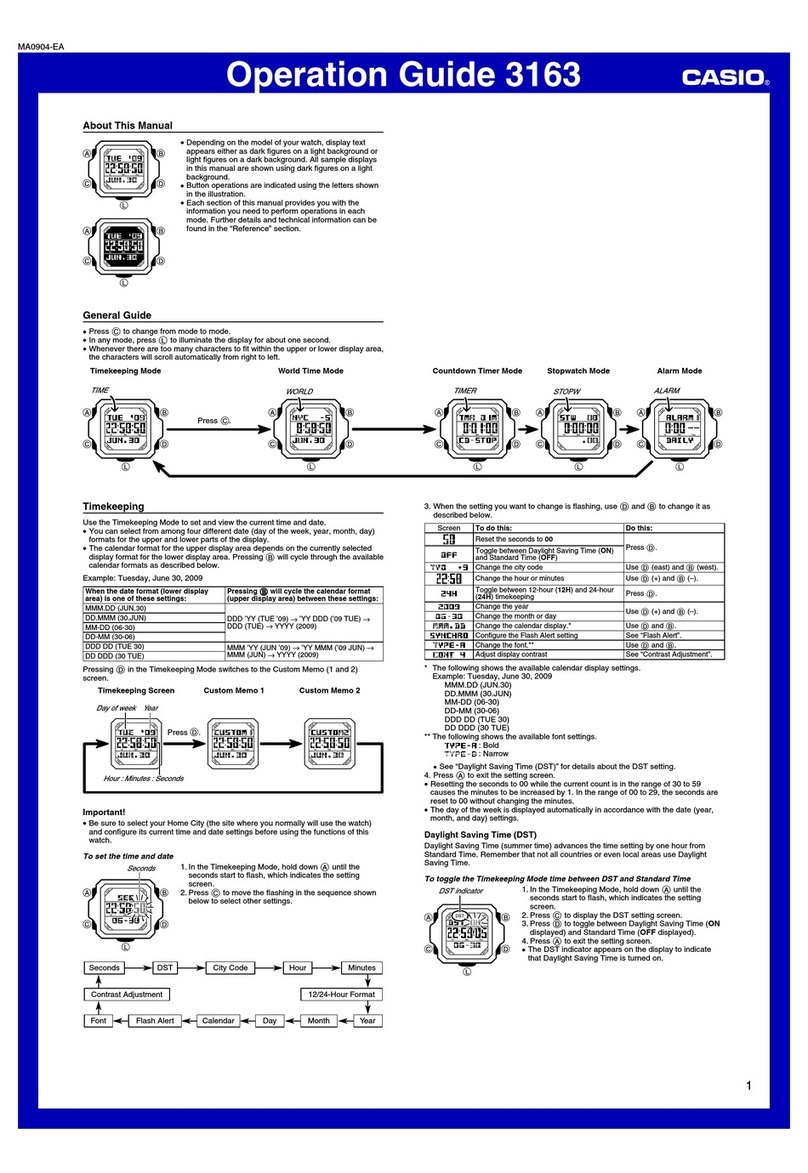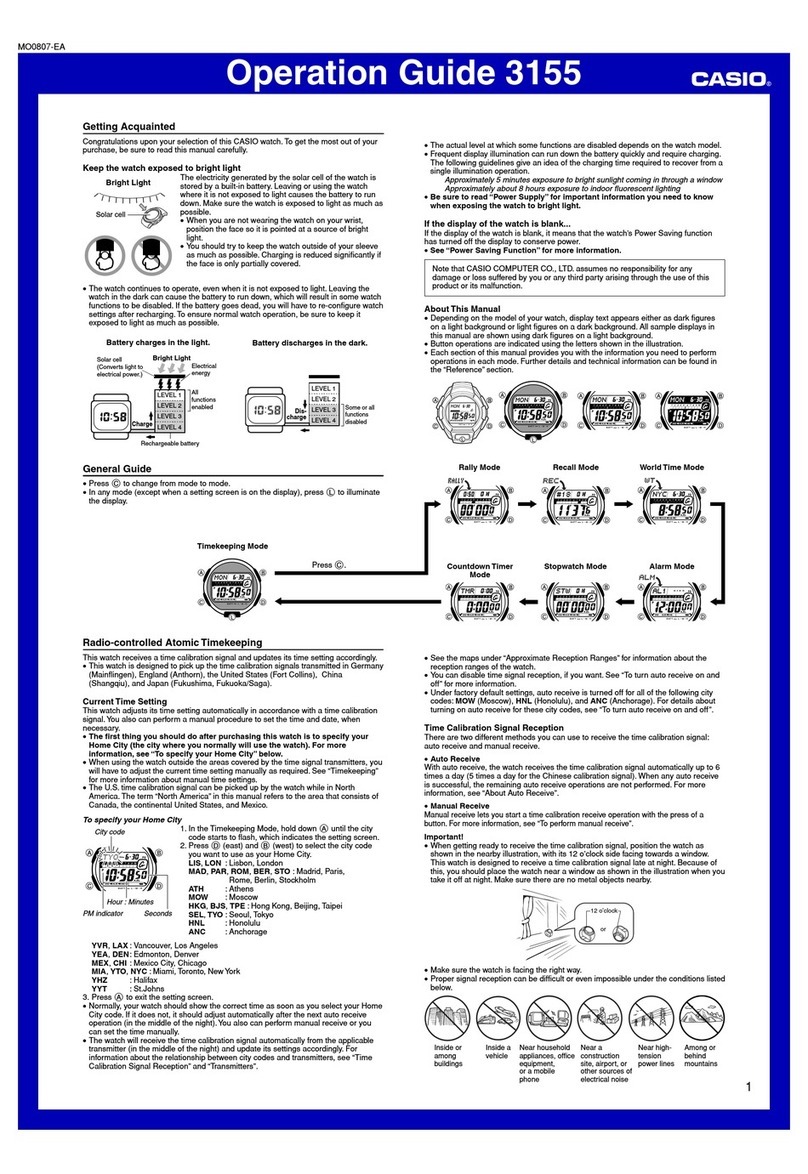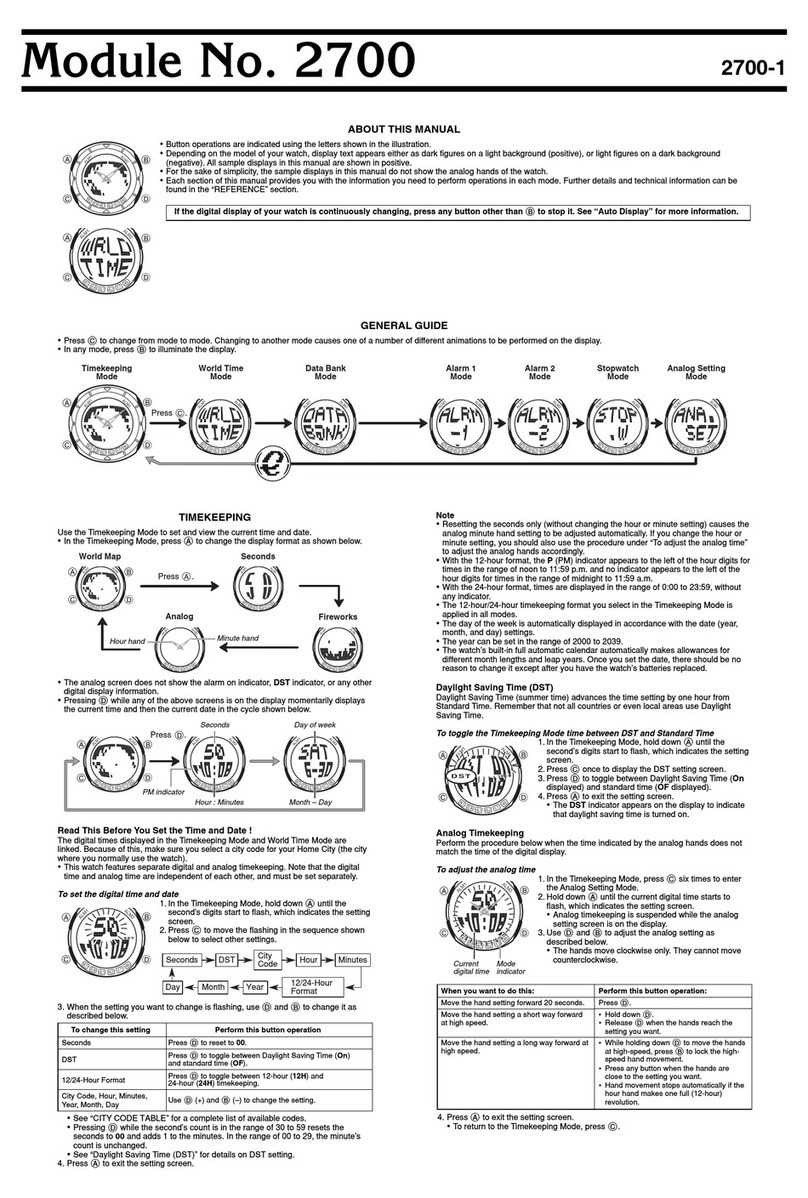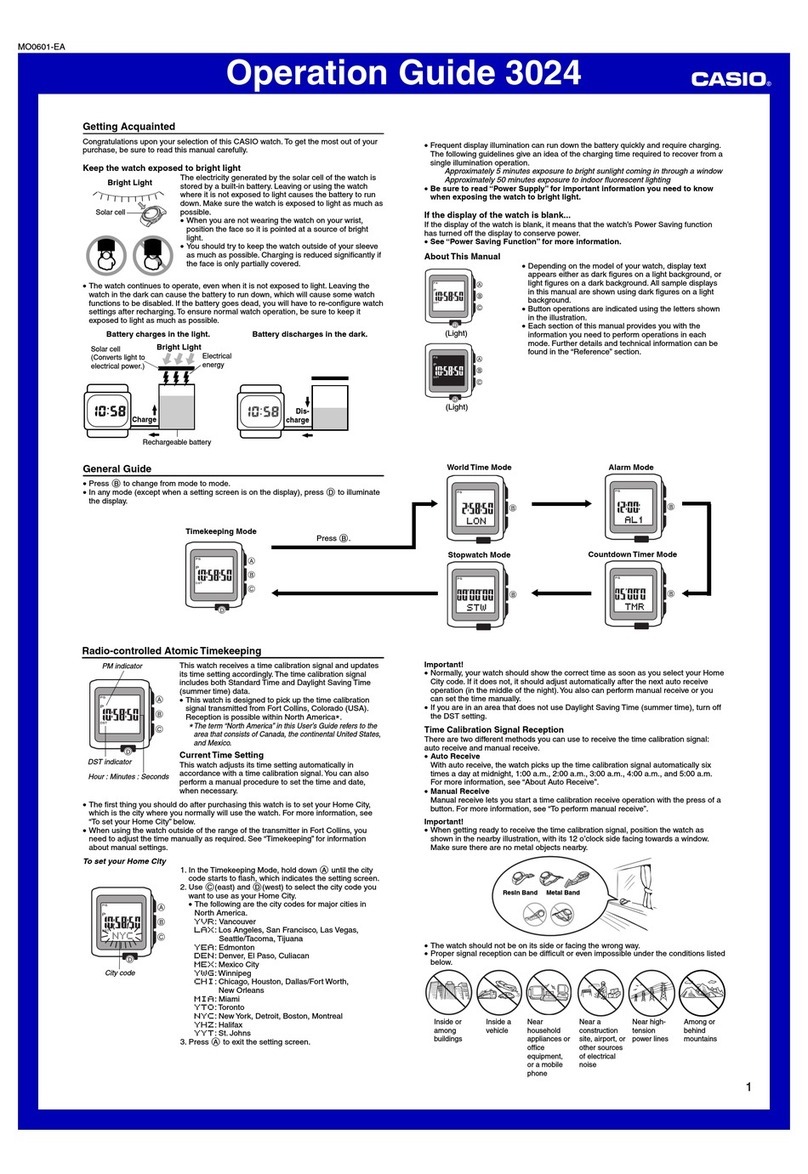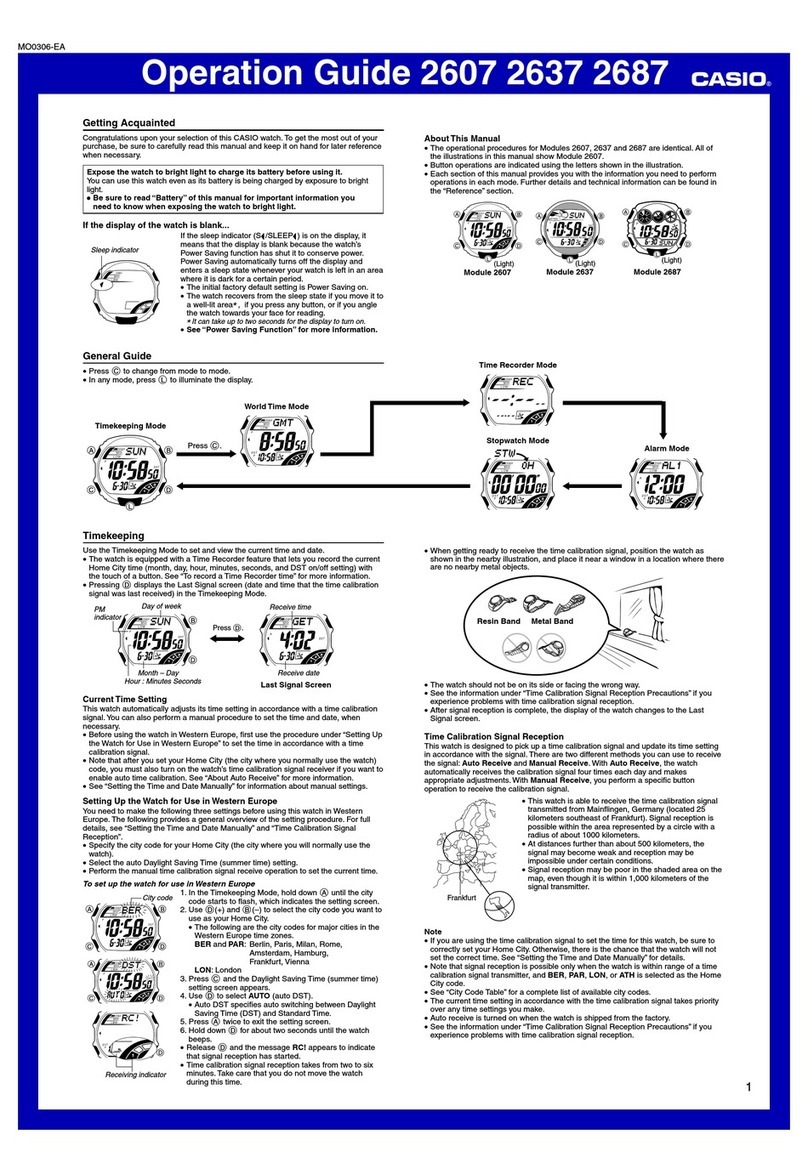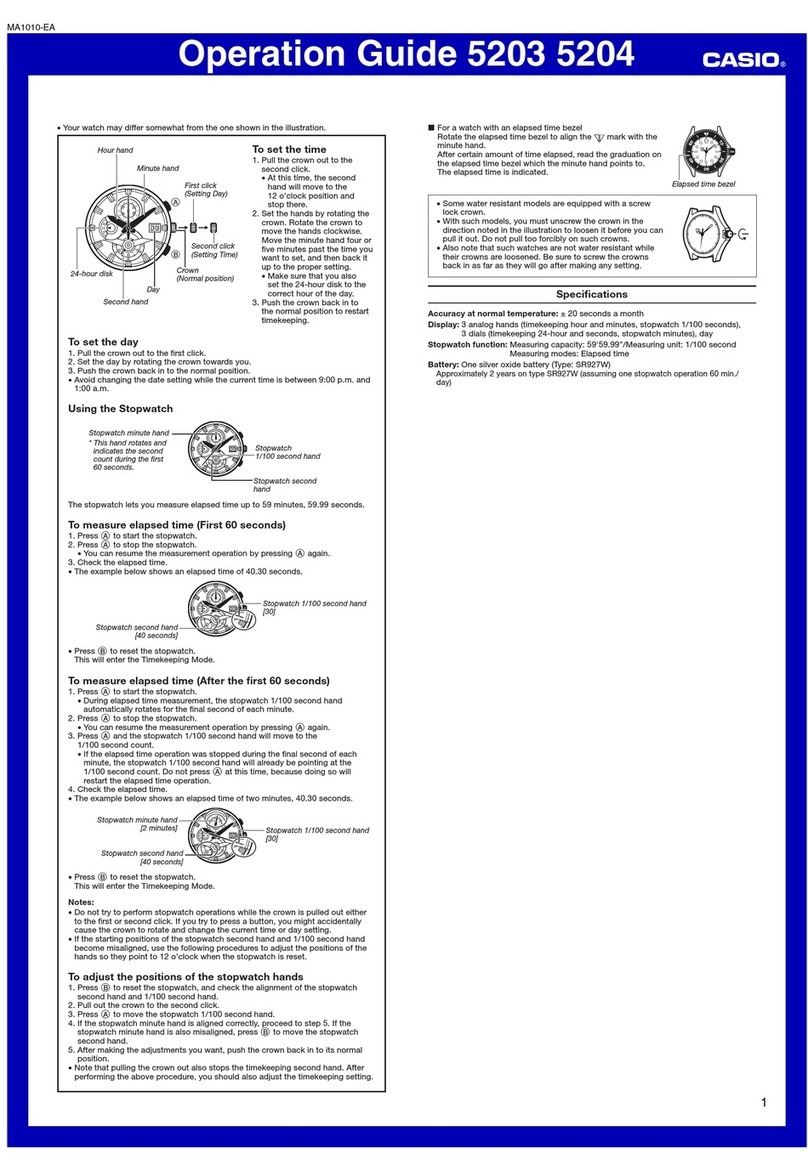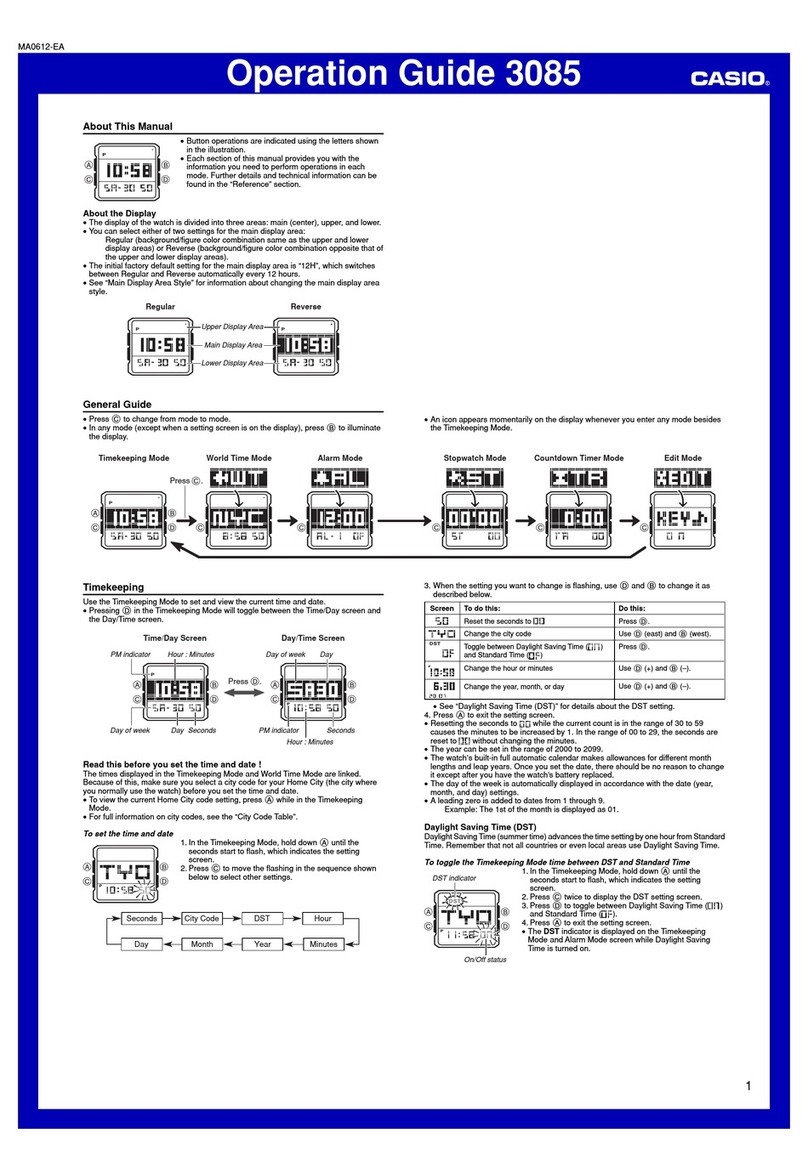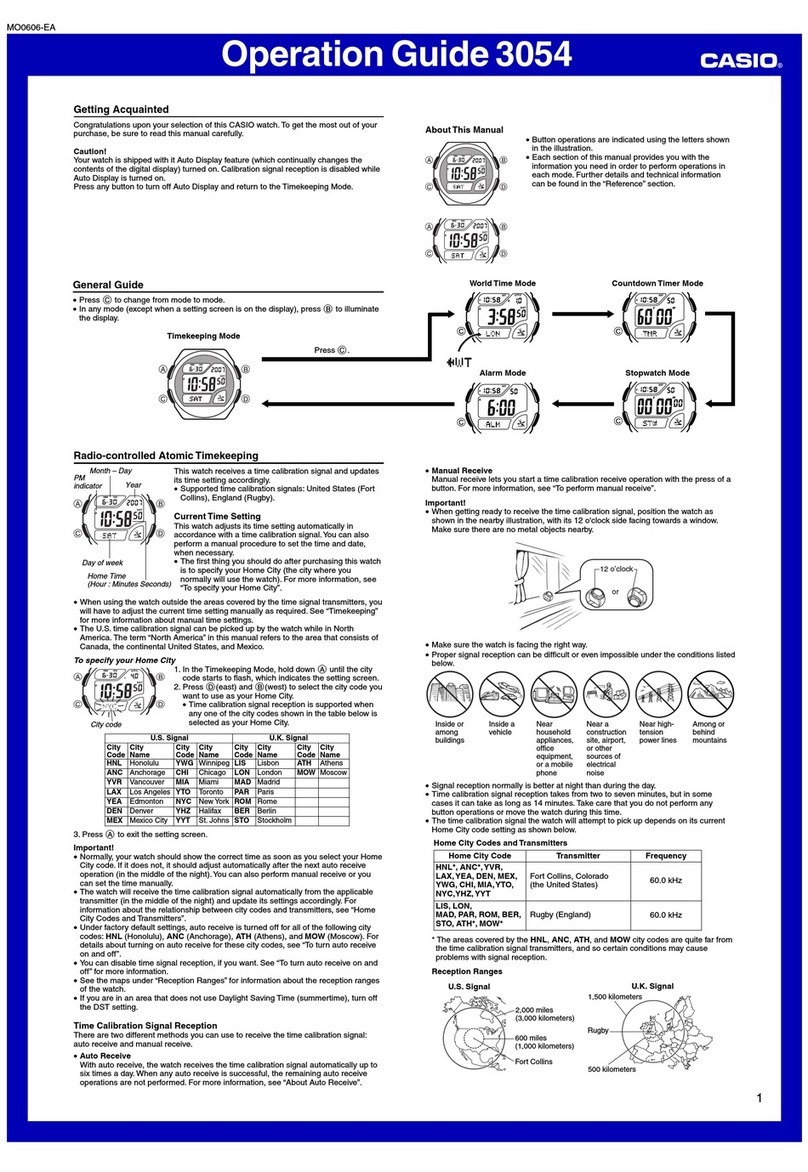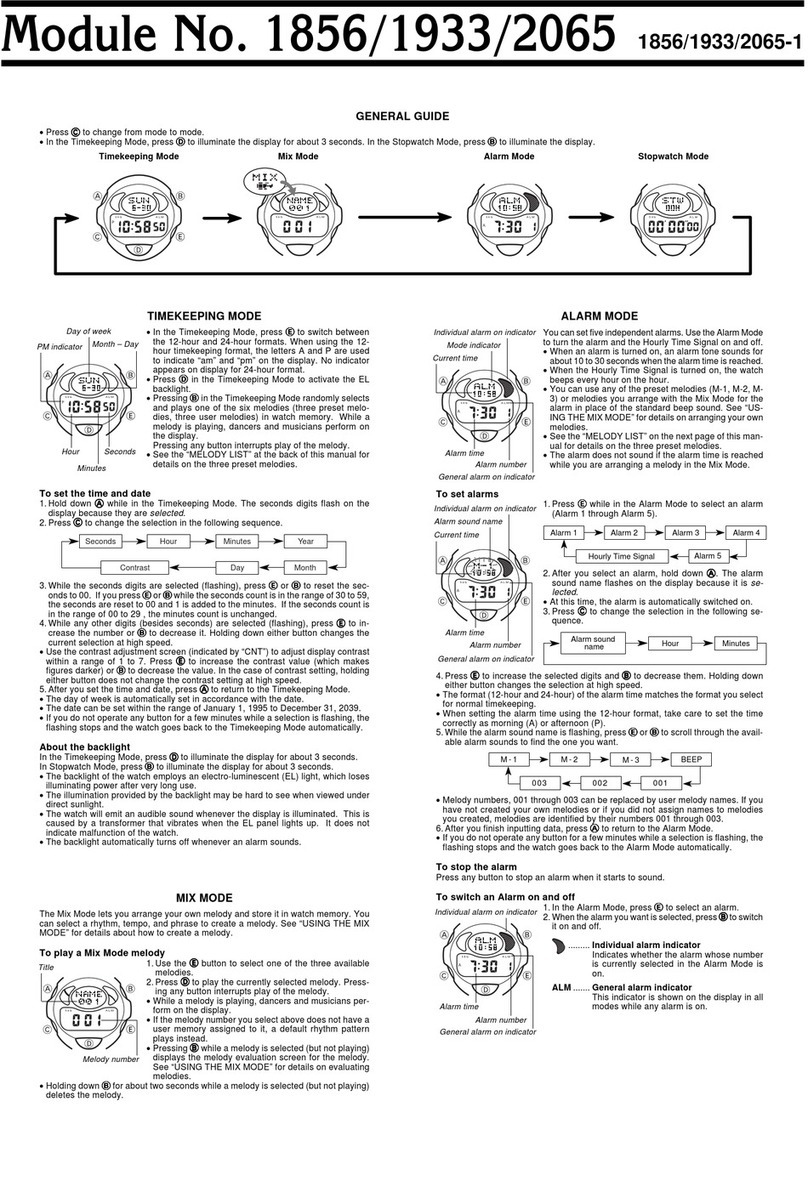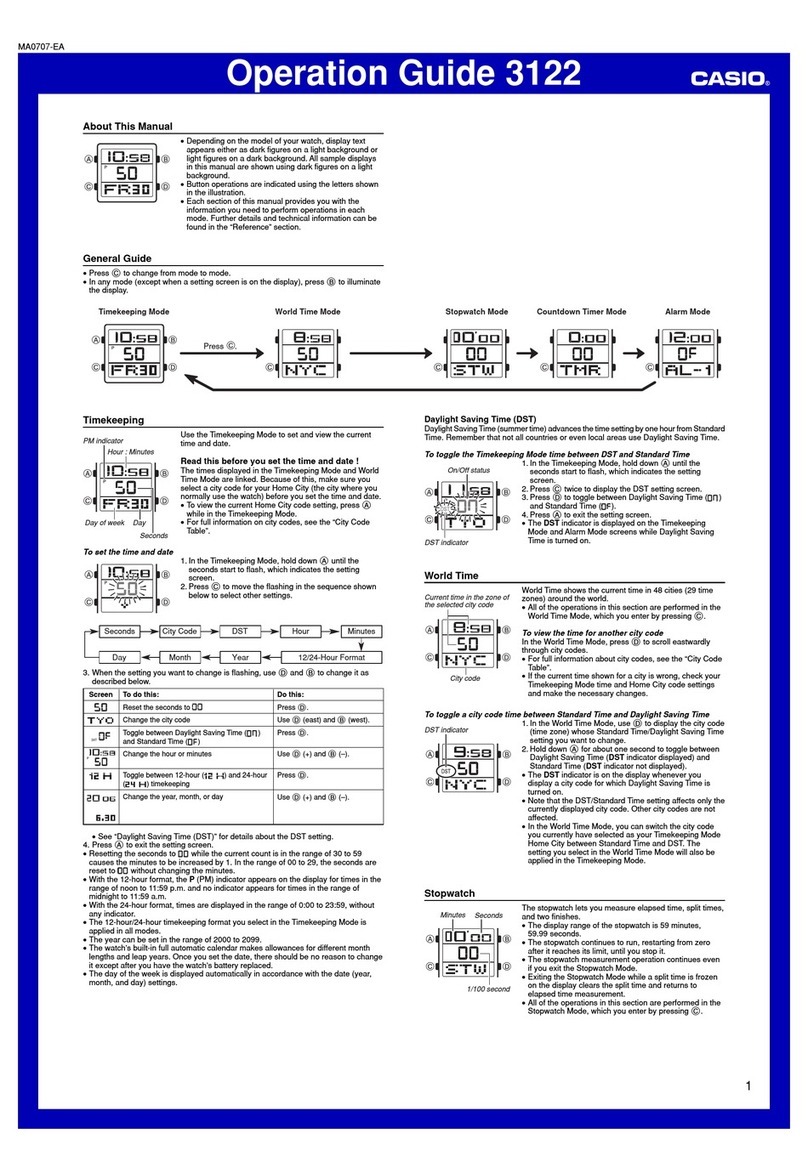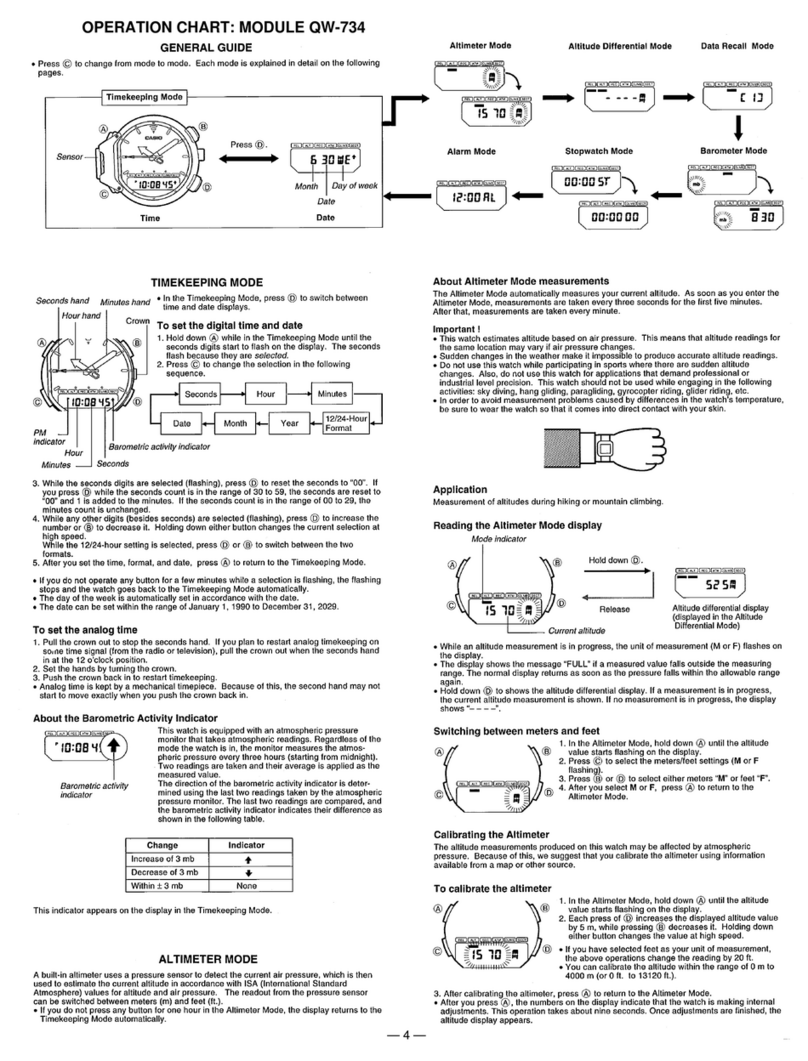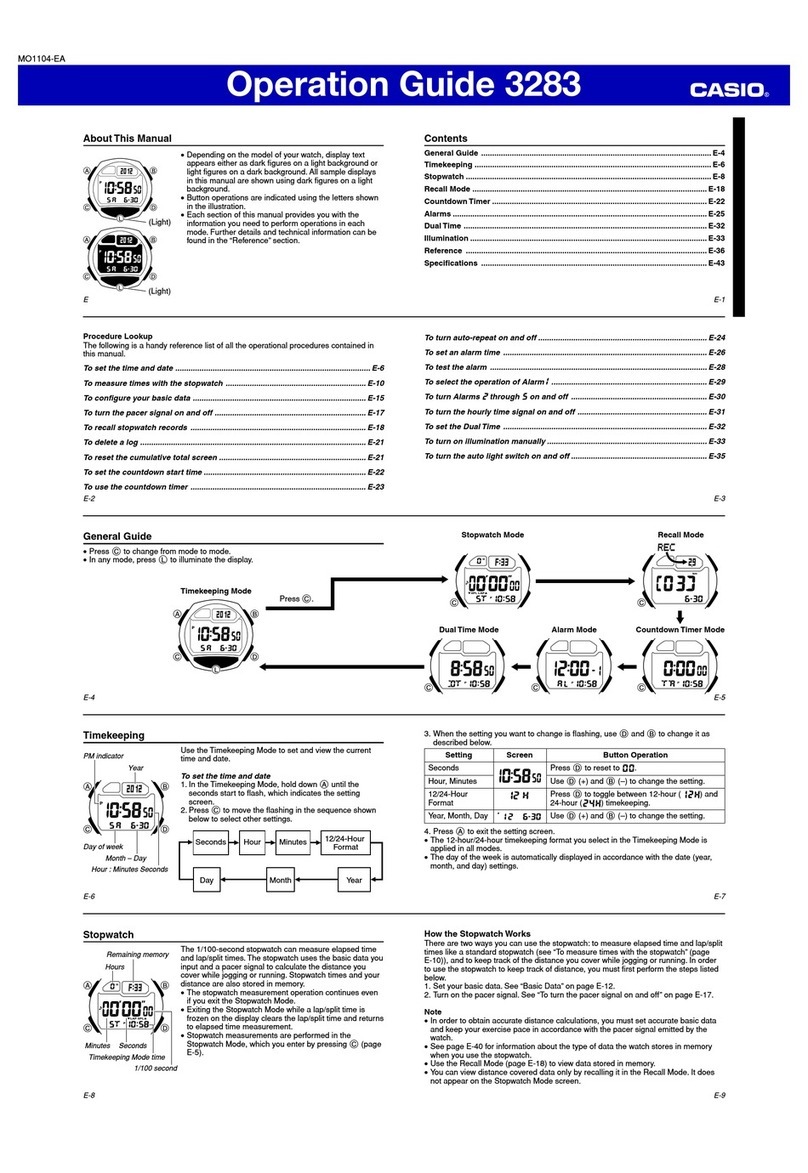
3
Operation Guide 5095
Dual Time is coordinated with regular timekeeping, and is maintained as a•
time differential from regular timekeeping current time. Changing the regular
timekeeping setting will cause the current Dual Time setting to change accordingly.
Hand Home Position Adjustment
If the time setting of your watch is not correct even though time calibration signal
reception is being performed normally, use the procedure in this section to check the
home positions of the hands and make adjustments as required.
Note that you do not need to perform the following operation if your watch is showing
the correct time.
Important!
When performing the following procedure, it is recommended that after you move to•
a home position, you press the Bbutton to move the setting back one step. Next,
press the Cbutton to return it to the home position. This helps to ensure better
home position adjustment accuracy.
It can take as long as 14 minutes for the hands of the watch to move to the•
12 o’clock position when you start home position adjustment. Following adjustment,
it can take as long as 14 minutes for the hands to return to normal timekeeping.
In the regular timekeeping, hold down1. Afor about
10 seconds until the cMinute Hand and xSecond
Hand move to 12 o’clock.
The•xSecond Hand goes through the sequence
described below. Last signal reception result →RC →
Current location setting →Keep Adepressed until
the xSecond Hand starts to move counterclockwise.
You can release Aat this time.
The•cMinute Hand and xSecond Hand are in their
correct home positions if they are pointed precisely
at 12 o’clock. If the hands are in the correct home
positions, advance to step 4.
If the current home positions are within ±15 minutes 00 seconds
Use2. C(+1 second) and B(–1 second) to adjust the
hand positions so they point to 12 o’clock.
Holding down either button for about two seconds and•
then releasing it starts high-speed hand movement in
the applicable direction.
To stop high-speed hand movement, press any•
button.
After adjusting the home positions, go to step 4.•
If the current home positions is greater than ±15 minutes 00 seconds
2. After performing step 1, hold down the Cand B
buttons at the same time until the zHour Hand,
cMinute Hand, xSecond Hand, and v24-hour Hand
all move to 12 o’clock.
Use3. C(+1 second) and B(–1 second) to adjust the
hand positions so they point to 12 o’clock.
Holding down either button for about two seconds and•
then releasing it starts high-speed hand movement in
the applicable direction.
To stop high-speed hand movement, press any•
button.
The•v24-hour Hand is synchronized with the zHour
Hand and cMinute Hand, so separate adjustment is
not required.
After adjusting the home positions, go to step 4.•
Press4. A. This will cause the nDual Time Hour Hand
and bDual Time Minute Hand to move to 12 o’clock for
home position adjustment.
The•nDual Time Hour Hand and bDual Time
Minute Hand are in their correct home positions if they
are pointed precisely at 12 o’clock. If the hands are in
the correct home positions, advance to step 6.
Use5. C(+1 minute) and B(–1 minute) to adjust the
hand positions so they point to 12 o’clock.
Holding down either button for about two seconds and•
then releasing it starts high-speed hand movement in
the applicable direction.
To stop high-speed hand movement, press any•
button.
After adjusting the home positions, go to step 6.•
Press6. Ato exit home position correction and return to regular timekeeping.
Troubleshooting
Hand Movement and Position
The xSecond Hand is moving at two second intervals.
All the watch’s hands are stopped at 12 o’clock and none of the buttons work.
Power may be low. Expose the watch to light until the xSecond Hand starts moving
normally, at one-second intervals.
The hands of the watch suddenly start moving at high speed, even when I do
not perform any operation.
This could be due to any one of the following causes. In all cases, the hand movement
does not indicate malfunction, and should stop shortly.
The watch is recovering from a sleep state.•
The time setting is being adjusted following a successful auto time calibration•
signal receive operation.
The current time setting is off by hours.
Your location setting may be wrong. Check your location setting and correct it, if
necessary.
The hands are off.
This could indicate that the watch has been exposed to magnetism or strong impact,
which has caused problems with proper hand alignment. Adjust the watch’s hand
home position alignment.
Charging
The watch does not resume operation after I expose it to light.
This can happen after the power level drops to Level 3. Continue exposing the watch
to light until the xSecond Hand starts moving normally
(at one-second intervals).
The xSecond Hand starts to move at one-second intervals, but then suddenly
returns to moving at two-second intervals.
The watch probably is not sufficiently charged yet. Continue keeping it exposed to
light.
Time Calibration Signal
The information in this section applies only when HONG KONG (HKG) or TOKYO
(TYO) is selected as the current location. You need to adjust the current time
manually when OFF is selected as the current location.
The xSecond Hand indicates NO (N) when I check the result of the latest
receive operation.
Possible Cause Remedy
You are wearing or moving the•
watch, or performing a button
operation during the signal receive
operation.
The watch is in an area with poor•
reception conditions.
Keep the watch in an area where reception
conditions are good while the signal receive
operation is being performed.
You are in an area where signal
reception is not possible for some
reason.
See “Approximate Reception Ranges”.
The calibration signal is not being
transmitted for some reason.
Check the website of the organization that•
maintains the time calibration signal in your area
for information about its down times.
Try again later.•
The current time setting changes after I set it manually.
You may have the watch configured for Auto Receive of the time calibration signal
which will cause the time to be adjusted automatically according to your currently
selected location. If this results in the wrong time setting, check your location setting
and correct it, if necessary.
Auto Receive is not performed or I cannot perform Manual Receive.
Possible Cause Remedy
Your location setting is wrong. Check your location setting and correct it, if
necessary.
There is not enough power for signal
reception. Expose the watch to light to charge it.
Signal reception is being performed successfully, but the time is wrong.
Possible Cause Remedy
Your location setting is wrong. Check your location setting and correct it, if
necessary.
The watch may have been exposed
to magnetism or strong impact, which
has caused problems with proper
hand alignment.
Adjust the watch’s hand home positions.
Specifications
Accuracy at normal temperature: ± 15 seconds a month (with no signal calibration)
Timekeeping: Hour, minutes, seconds, 24-hour
Time Calibration Signal Reception: Auto receive up to three times a day; Manual
receive
Receivable Time Calibration Signals:
Fukushima, Japan (Call Sign: JJY, Frequency: 40.0 kHz); Fukuoka/
Saga, Japan (Call Sign: JJY, Frequency: 60.0 kHz); Shangqiu City,
Henan Province, China (Call Sign: BPC, Frequency: 68.5 kHz)
Dual Time: Hour, minutes
Setting Unit: 30 minutes
Other: Power Saving
Power Supply: Solar cell and one rechargeable battery
Approximate battery operating time: 8 months (no exposure to light after a full
charge; signal reception of approximately 3 minutes per day)








